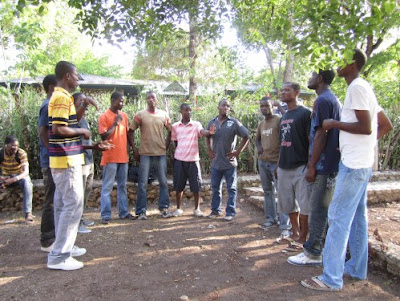This month was an exciting one as we continued our education program, distributed tools to community nurseries, broke ground on our new central nursery project, hosted many guests and visitors, and welcomed back a former intern to Deschapelles. This month’s lesson covered tree nurseries, and HTRIP technicians taught community participants about seed germination and care for tree seedlings. They also covered general nursery management principles, like laying out even rows of seedlings for better accounting, and new communities selected a suitable location for their tree nurseries—as near as possible to a water source (for watering seedlings during the dry season), on a slight slope (so that water drains and seedlings do not drown in the rainy season), and with a mixture of sun and shade (so that trees can be acclimated and avoid sunburn). November’s lesson covers tree seed collection and storage.
The education program always corresponds with our community activities, and we spent much of this month purchasing and distributing tools for community nurseries. Each community that participates in the HTRIP program receives basic support for its own nursery, each of which produces between 4,000 and 7,000 trees each year. HTRIP supports community nurseries by subsidizing the material cost of production of the seedlings (the community members do all the work themselves) and by providing simple equipment like picks, shovels, germinating pans, and water drums.

 |
| These are views of the progress on the entire nursery space, including the foundations for the "gazebo" meeting-place structure. |

 |
| Construction progress on HTRIP nursery water tower foundations. |
With this in mind, we also began work on our central HTRIP nursery in Deschapelles this month—and this year, it meant starting construction in a new-to-us space on the Hospital campus which was unused and overgrown until recently (see photo at right). The $13K project will include a small water tower, a “depot” equipment storage space, a wide gate and access road, and a small gazebo like building in which to hold staff meetings. We expect this new nursery space to meet all of HTRIP’s needs for the foreseeable future, and immediately it will allow us to increase our nursery production to more than 80,000 trees this year at the same time that it allows us the space for a larger central composting operation and a grasses program. This month, we finished most of the foundations (see photos). We expect to finish the major construction work by the end of November and have everything else in place and fully operational by the end of the year.
Among the many guests and visitors we welcomed to Deschapelles this month was Ross Bernet, a recent graduate of UCLA in environmental science who completed an internship with HTRIP in the summer of 2010 researching the effects of geospatial human and ecological factors on tree growth in HTRIP filial plots. This year, he will be contributing more to project logistics and long-term management strategy while he continues his research.
 |
Construction progress on the HTRIP nursery. Above, foundations are being built for the forty-foot shipping container that will serve as a "depot" storage space. |
Although we suffered from a shortened rainy season this summer, we’ve been benefitting from an unusually wet “second rainy season”, so we hope that tree mortality this year will not be as high as we originally thought. HTRIP staff will soon begin the long process of surveying the over eight hundred new “filial” tree plots this year, and we will know for sure in the early months of 2012.
We look forward to an exciting and productive November and thank you all for your continuing support,
The HTRIP Staff,
including Starry Sprenkle, Dan
Langfitt and Ross Bernet.
































